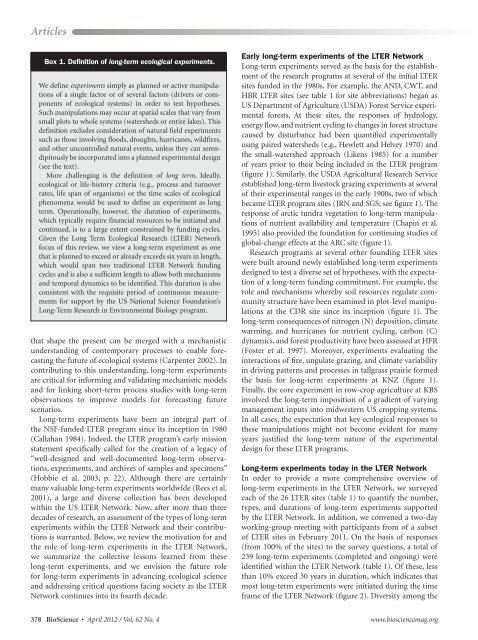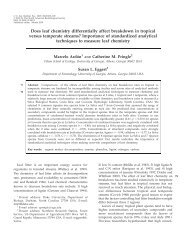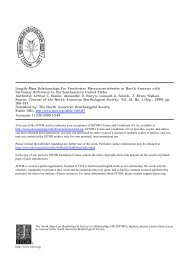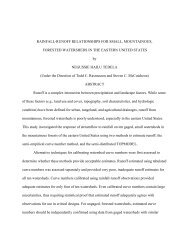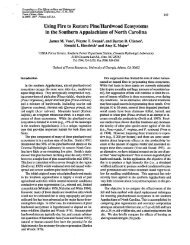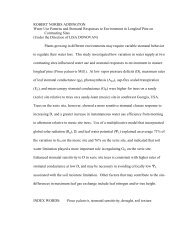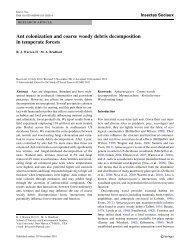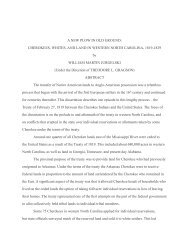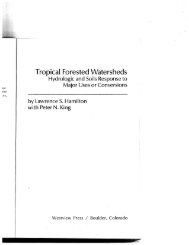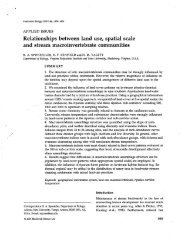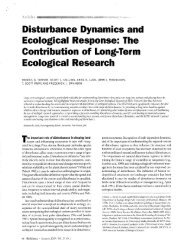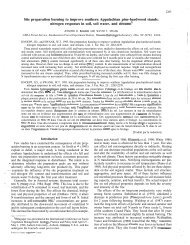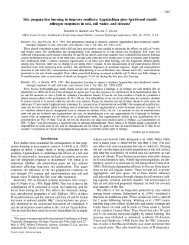biology join - Coweeta LTER - University of Georgia
biology join - Coweeta LTER - University of Georgia
biology join - Coweeta LTER - University of Georgia
You also want an ePaper? Increase the reach of your titles
YUMPU automatically turns print PDFs into web optimized ePapers that Google loves.
Articles<br />
Box 1. Definition <strong>of</strong> long-term ecological experiments.<br />
We define experiments simply as planned or active manipulations<br />
<strong>of</strong> a single factor or <strong>of</strong> several factors (drivers or components<br />
<strong>of</strong> ecological systems) in order to test hypotheses.<br />
Such manipulations may occur at spatial scales that vary from<br />
small plots to whole systems (watersheds or entire lakes). This<br />
definition excludes consideration <strong>of</strong> natural field experiments<br />
such as those involving floods, droughts, hurricanes, wildfires,<br />
and other uncontrolled natural events, unless they can serendipitously<br />
be incorporated into a planned experimental design<br />
(see the text).<br />
More challenging is the definition <strong>of</strong> long term. Ideally,<br />
ecological or life-history criteria (e.g., process and turnover<br />
rates, life span <strong>of</strong> organisms) or the time scales <strong>of</strong> ecological<br />
phenomena would be used to define an experiment as long<br />
term. Operationally, however, the duration <strong>of</strong> experiments,<br />
which typically require financial resources to be initiated and<br />
continued, is to a large extent constrained by funding cycles.<br />
Given the Long Term Ecological Research (<strong>LTER</strong>) Network<br />
focus <strong>of</strong> this review, we view a long-term experiment as one<br />
that is planned to exceed or already exceeds six years in length,<br />
which would span two traditional <strong>LTER</strong> Network funding<br />
cycles and is also a sufficient length to allow both mechanisms<br />
and temporal dynamics to be identified. This duration is also<br />
consistent with the requisite period <strong>of</strong> continuous measurements<br />
for support by the US National Science Foundation’s<br />
Long-Term Research in Environmental Biology program.<br />
that shape the present can be merged with a mechanistic<br />
understanding <strong>of</strong> contemporary processes to enable forecasting<br />
the future <strong>of</strong> ecological systems (Carpenter 2002). In<br />
contributing to this understanding, long-term experiments<br />
are critical for informing and validating mechanistic models<br />
and for linking short-term process studies with long-term<br />
observations to improve models for forecasting future<br />
scenarios.<br />
Long-term experiments have been an integral part <strong>of</strong><br />
the NSF-funded <strong>LTER</strong> program since its inception in 1980<br />
(Callahan 1984). Indeed, the <strong>LTER</strong> program’s early mission<br />
statement specifically called for the creation <strong>of</strong> a legacy <strong>of</strong><br />
“well-designed and well-documented long-term observations,<br />
experiments, and archives <strong>of</strong> samples and specimens”<br />
(Hobbie et al. 2003, p. 22). Although there are certainly<br />
many valuable long-term experiments worldwide (Rees et al.<br />
2001), a large and diverse collection has been developed<br />
within the US <strong>LTER</strong> Network. Now, after more than three<br />
decades <strong>of</strong> research, an assessment <strong>of</strong> the types <strong>of</strong> long-term<br />
experiments within the <strong>LTER</strong> Network and their contributions<br />
is warranted. Below, we review the motivation for and<br />
the role <strong>of</strong> long-term experiments in the <strong>LTER</strong> Network,<br />
we summarize the collective lessons learned from these<br />
long-term experiments, and we envision the future role<br />
for long-term experiments in advancing ecological science<br />
and addressing critical questions facing society as the <strong>LTER</strong><br />
Network continues into its fourth decade.<br />
Early long-term experiments <strong>of</strong> the <strong>LTER</strong> Network<br />
Long-term experiments served as the basis for the establishment<br />
<strong>of</strong> the research programs at several <strong>of</strong> the initial <strong>LTER</strong><br />
sites funded in the 1980s. For example, the AND, CWT, and<br />
HBR <strong>LTER</strong> sites (see table 1 for site abbreviations) began as<br />
US Department <strong>of</strong> Agriculture (USDA) Forest Service experimental<br />
forests. At these sites, the responses <strong>of</strong> hydrology,<br />
energy flow, and nutrient cycling to changes in forest structure<br />
caused by disturbance had been quantified experimentally<br />
using paired watersheds (e.g., Hewlett and Helvey 1970) and<br />
the small-watershed approach (Likens 1985) for a number<br />
<strong>of</strong> years prior to their being included in the <strong>LTER</strong> program<br />
(figure 1). Similarly, the USDA Agricultural Research Service<br />
established long-term livestock grazing experiments at several<br />
<strong>of</strong> their experimental ranges in the early 1900s, two <strong>of</strong> which<br />
became <strong>LTER</strong> program sites (JRN and SGS; see figure 1). The<br />
response <strong>of</strong> arctic tundra vegetation to long-term manipulations<br />
<strong>of</strong> nutrient availability and temperature (Chapin et al.<br />
1995) also provided the foundation for continuing studies <strong>of</strong><br />
global-change effects at the ARC site (figure 1).<br />
Research programs at several other founding <strong>LTER</strong> sites<br />
were built around newly established long-term experiments<br />
designed to test a diverse set <strong>of</strong> hypotheses, with the expectation<br />
<strong>of</strong> a long-term funding commitment. For example, the<br />
role and mechanisms whereby soil resources regulate community<br />
structure have been examined in plot-level manipulations<br />
at the CDR site since its inception (figure 1). The<br />
long-term consequences <strong>of</strong> nitrogen (N) deposition, climate<br />
warming, and hurricanes for nutrient cycling, carbon (C)<br />
dynamics, and forest productivity have been assessed at HFR<br />
(Foster et al. 1997). Moreover, experiments evaluating the<br />
interactions <strong>of</strong> fire, ungulate grazing, and climate variability<br />
in driving patterns and processes in tallgrass prairie formed<br />
the basis for long-term experiments at KNZ (figure 1).<br />
Finally, the core experiment in row-crop agriculture at KBS<br />
involved the long-term imposition <strong>of</strong> a gradient <strong>of</strong> varying<br />
management inputs into midwestern US cropping systems.<br />
In all cases, the expectation that key ecological responses to<br />
these manipulations might not become evident for many<br />
years justified the long-term nature <strong>of</strong> the experimental<br />
design for these <strong>LTER</strong> programs.<br />
Long-term experiments today in the <strong>LTER</strong> Network<br />
In order to provide a more comprehensive overview <strong>of</strong><br />
long-term experiments in the <strong>LTER</strong> Network, we surveyed<br />
each <strong>of</strong> the 26 <strong>LTER</strong> sites (table 1) to quantify the number,<br />
types, and durations <strong>of</strong> long-term experiments supported<br />
by the <strong>LTER</strong> Network. In addition, we convened a two-day<br />
working-group meeting with participants from <strong>of</strong> a subset<br />
<strong>of</strong> <strong>LTER</strong> sites in February 2011. On the basis <strong>of</strong> responses<br />
(from 100% <strong>of</strong> the sites) to the survey questions, a total <strong>of</strong><br />
239 long-term experiments (completed and ongoing) were<br />
identified within the <strong>LTER</strong> Network (table 1). Of these, less<br />
than 10% exceed 30 years in duration, which indicates that<br />
most long-term experiments were initiated during the time<br />
frame <strong>of</strong> the <strong>LTER</strong> Network (figure 2). Diversity among the<br />
378 BioScience • April 2012 / Vol. 62 No. 4 www.biosciencemag.org


